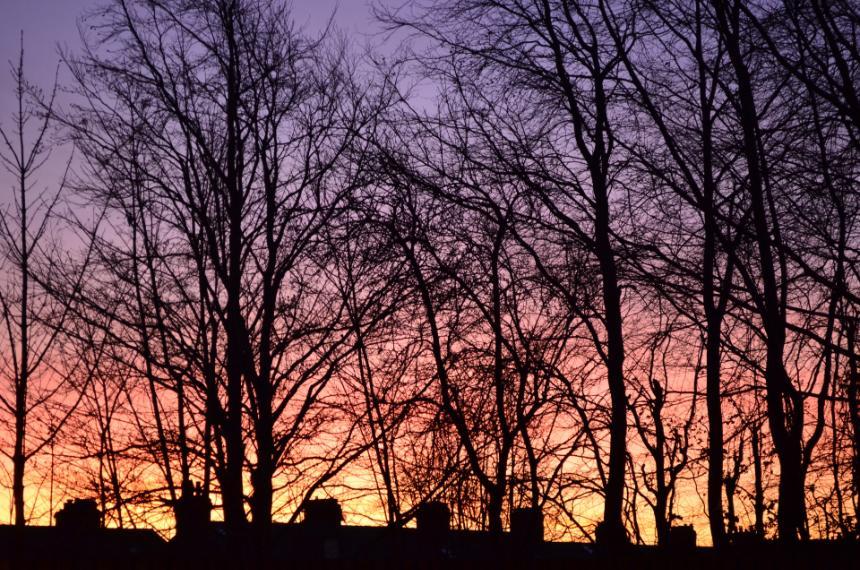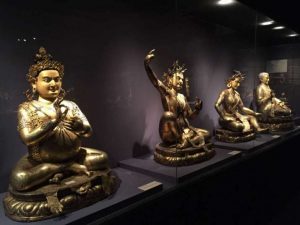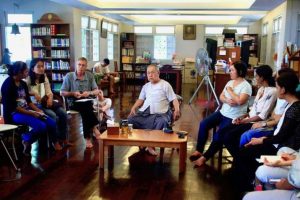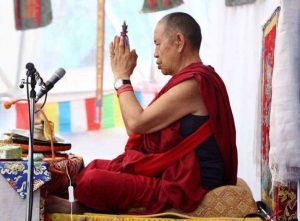Life is art. Art is life. I never separate it.
(Ai Weiwei)
Blend my skin with rain-rippled oceans, mingle my ears with thunder and the thrumming of gulls, infuse my eyes with molten grey skies. Feel the pulse of this place – the huge windswept body of water and stone, this vexed and hurt being in whose flesh I am entangled – beaming earth, becoming animal. Becoming in this manner – fully human.
(Dalziel and Scullion, from an exhibition at Dovecot Studios, Edinburgh, 2014)

It’s that time of the year when I can observe the sun rising between the dark tangle of bare trees outside our bay window. I sit there in my dressing gown, sipping my wake-up mug of green tea with grated ginger, deliberately making this process of looking part of my morning practice, doing my best to be present with the slow unfolding of a spectacular show of color reflected on the bands of cloud on the horizon. The gradual changes of tone from deep red, through shades of pink, to milky white have inspired human beings through the centuries, particularly those of us of an artistic bent. We may have searched our brains to name the colors, wondered how to mix this pale apricot, this mauve grey, and eventually surrendered to simply looking, letting the moment work its magic, taking us out of the humdrum of ordinary wakefulness into vivid presence, where sometimes the outer mystery connects to an inner clarity and stillness beyond words.
My neighbors will shortly post photos of it in the community WhatsApp group, but I long ago realized that nothing replaces the actual, fleeting experience of looking at something beautiful in real time in a real place. You have to slow down, come into a different, non-possessive, non-controling relationship with the phenomenon that caught your interest.
If I had woken up a little later and opened the curtains on the current scene, I would in all likelihood have missed the delightful nuances of grey, the last hint of pink that might almost be a green, missed the moment when the clear blue of the atmosphere became more astonishing than the clouds. I needed that period of mindful looking, and the writing about it, to hone my eyes to see the extraordinariness in the everyday. A similar process takes place when deliberately slowing down to look at art. And the same is true in making art, which is one of the things I do.
As part of his enquiry into “time management for mortals,” British author and journalist Oliver Burkeman submitted himself to the instructions given by Jennifer Roberts to her art history students at Harvard University. You are to choose a work of art in a gallery or museum and look at it for three hours straight. “And so you wait,” he writes:
Grumpiness gives way to fatigue, then restless irritation. Time slows and sags. You wonder if an hour has passed, but when you check your watch, you find it’s been seventeen minutes. And then, around the eighty-minute mark, but without you noticing precisely when or how it happened, there’s a shift. You finally give up attempting to escape the discomfort of time passing so slowly, and the discomfort abates. And the Degas begins to reveal its secret details: subtle expressions of watchfulness and sadness on the faces of the three men – one of whom, you notice properly for the first time, is a black merchant in an otherwise white milieu.’ The reward for his patience is the experience that things have a kind of ‘chewiness’ into which ‘you can sink your teeth’, and a sense of ‘really getting stuck in to life.’
(Burkeman, 174)
I took a risk during the opening of my recent art exhibition and invited the visitors to follow my guidance to look mindfully at a work of art of their choice. Far from a three-hour ordeal, it took just over 10 minutes of standing still—I think I may have rushed it a little—but even so, it could have made people feel uncomfortable, being unused to silence perhaps, or a sense of inadequacy and awkwardness. In actual fact, people seemed to love it and asked me to repeat it. Someone even stayed for all of the three periods of the guided meditation during the evening, and some came back at other viewing times with their relations to be taken through a similar experience.
My husband hosted a writing group in the space, using the guided meditation as a pre-cursor to writing, and some interesting pieces came out of it. One of my paintings reminded a woman of the novel The English Patient by Michael Ondaatje and she wrote a poem about it, including the lines: they wrapped his charred black skin / in oils & balms & / carried him from water hole to water hole / for they knew the oases / in daytime burning heat all yellow light / at night the sand the sound of insects farting camels stars.

I sent the poem to my friend Dan who had bought the painting—he will tape it to the back. I love it when connections like this happen. I am not too sure how it is related to the theme of mindful looking, but I wanted to share it with you anyway.
Here is the write-up of the guided meditation, in case you may want to take some ideas from it for looking mindfully at art, sunrises, a landscape, or anything really. There is also a recorded version.
Mindfully Looking at Art, a guided meditation by Ratnadevi
For use in art exhibitions and at home
I invite you to walk around the rooms in silence, initially as a walking meditation. Walk at a normal pace, being aware of the body in motion, particularly the contact of your feet with the ground. Your eyes may pull you towards the objects on the walls, but for now we keep our attention quite broad, taking in the effect of the space on your whole body, how it fits this space. You may also sense the proximity of other people milling around you, the collective aural impact of footsteps, creaking floor boards, the temperature in various parts of the space, the quality of light, any smells or tastes.
Keeping your awareness relaxed and open, you start noticing the pieces of art on the walls more, registering any passing responses, taking note if any of them calls you more than others. For now, don’t look at titles or prices, this is not about possibly owning anything, it’s simply an opportunity for an open, appreciative encounter with the art. There may be memories of visiting art exhibitions, which may have been enjoyable or daunting experiences, just acknowledging that may help you to be present for a potentially new experience.
Now make your way to one piece that seems to call you, that you are most interested in. Find a comfortable position from where you can look at the painting. (At some point you may want to change the distance, to allow for a slightly different experience.)
Perhaps there are certain questions alive in you, like, what does it represent, what does it remind you of. How was it made? A sense of curiosity.
Let’s take that curiosity a bit more towards you as the observer. Do you have a physical response to the piece, like a gut, or a heart resonance? Does it make you feel a particular way? Or do you like how it stimulates your thinking?
Let’s explore the act of looking itself — the eyes obviously play a role here. Let’s experiment a little, what would it be like to look at it from your belly — from your feet — from the earth — do you see or feel different things? Maybe different dimensions of the painting reveal themselves when you look from your heart — from an area just above your head — from 2 meters behind you.
How would it be to look at it from before you were born? Or after you have died?
Keep looking at the painting from the place that feels most alive just now, staying relaxed and open, soft. Let yourself explore some of the formal elements of the painting — how your eyes are invited by the lines and shapes to roam across the picture plane — horizontally, vertically, diagonally, in circles or in random movements? Are you intrigued by particular colours, textures, contrast, rhythms, the interplay of background/ foreground? Allow yourself to become absorbed in seeing how different aspects of the painting communicate with each other, play off each other, augment each other, balance each other out. There may be areas of activity and areas of rest. There could be a particular interest in investigating border areas, where the painting meets the frame, or where one field of colour meets another.
Does it seem like one of the elements, earth, water, fire or air comes alive in this painting?
The picture frame is like a window that gives you a view of a particular reality, an unfolding story you are playing an active part in, just as I as the maker played a part in. If you know me, that knowing plays a role in how you perceive the painting, It’s a bit like listening to a piece of music by a familiar composer — in some mysterious way they become present through you listening to the music. You could call it projection, if you like.
Talking of listening — what kind of music would go with this painting, what scent, what taste? In your imagination, how would your body move inside the painting — or maybe it invites your body to be still inside it?
The making of the piece was an improvisation, and it continues now in your active listening presence. In a way, it has become our painting, our dance. If you were to add a mark or a wash of colour to this painting, what might it be?
How is your breathing part of it?
Finally, imagine this piece of art has a message for you — what does it say? Receive it as a gift to you, a blessing and allow yourself to be nourished by it.
Then find a fitting way, a small gesture perhaps to end this meeting.
Thinking back to the sunrise, I want to leave you with this short poem by the Persian poet Hafiz:
Even
After
All this time
The Sun never says to the Earth,
You owe me.Look
What happens
With a love like that,
It lights up the whole sky.
References
Burkman, Oliver. 2021. Four Thousand Weeks: Time Management for Mortals. New York: Farrar, Straus and Giroux.
See more
Mindfully Looking at Art, a meditation guided by Ratnadevi (YouTube)
Related features from BDG
Book Review: In the Present Moment: Buddhism, Contemporary Art, and Social Practice
Abstract Meditations and Artistic Contemplation, with Françoise Issaly
Curiosity
Vivid Realizations: A Journey Through Buddhist Art
Expressing the Inner Light: The Luminescent Art of Sarah Brayer
Related news reports from BDG
Berkeley Art Museum Exhibits Artwork from Hong Kong Buddhist Wesley Tongson
Buddhist Artist Bernice Bing Receives Solo Show at the Asian Art Museum
Seoul International Buddhism Expo to Focus on Ritual
New York’s Rubin Museum Offers an Immersion into Buddhist Wisdom and Practice














